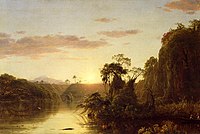Sanford Robinson Gifford
Sanford Robinson Gifford (July 10, 1823 – August 29, 1880) was an American landscape painter and a leading member of the second generation of Hudson River School artists.He was born in Greenfield, New York, the fourth of the eleven children of Quaker ironmaker Elihu Gifford and Eliza Robinson Starbuck.[3] Like most Hudson River School artists, Gifford traveled extensively to find scenic landscapes to sketch and paint.During the summer of 1867, Gifford spent most of his time painting on the New Jersey coast, specifically at Sandy Hook and Long Branch, according to an auction Web site.The Mouth of the Shrewsbury River, one noted canvas from the period, is a dramatic scene depicting a series of telegraph poles extending into an atmospheric distance underneath ominous storm clouds.Then in the summer of 1870 Gifford ventured to the Rocky Mountains in the western United States, this time with Worthington Whittredge and John Frederick Kensett.[7] Mr. Gifford's method is this: When he sees anything which vividly impresses him, and which therefore he wishes to reproduce, he makes a little sketch of it in pencil on a card about as large as an ordinary visiting-card.Ten, eleven, twelve consecutive hours, according to the season of the year, are occupied in the first great effort to put the scene on canvas."[9] In the same letter, he wrote about his commission fees: "The price of such a picture the size of the [Fishing Boats Entering the Harbor of] Brindisi is $1600 without the frame.Among the more important pictures that are displayed may be noted Twilight in the Wilderness (1861), Kauterskill Clove (1863), Mansfield Mountain (1868), The Mouth of the Shrewsbury (1868), Sta.Tivoli and Lake Geneva are no less admirable, but with a very distinct sentiment, and Pallanza, Lago Maggiore has a full-blooded sense of light, modified by tone that is in every respect masterly in treatment.Two pictures by the same artist, Fishing-Boats of the Adriatic and San Giorgio, Venice, are as strong and pronounced in color as the former works are delicate and suggestive.The crowd was larger than anticipated, and with some 800 people packed into the building, the floor of the ballroom collapsed, in what became known as the Madison Square Garden disaster.Prior to joining AAMD, the Academy had sold two Thomas Eakins works (including his "diploma painting," Wrestlers) in the 1970s, and Richard Caton Woodville's War News from Mexico (1848) in 1994."[20] In a 2008 sale, the Academy quietly sold Frederic Edwin Church‘s Scene on the Magdalene (1854) and Sanford Gifford's Mount Mansfield, Vermont (1859) to a private collector for US$13.5 million.




















Greenfield, New YorkLandscape artPaintingLuminismHudson River SchoolHudson, New YorkBrown UniversityJohn Rubens SmithNational Academy of DesignAlbert BierstadtWorthington WhittredgeMount MansfieldHome JournalMetropolitan Museum of Art7th Regiment of the New York MilitiaUnion League Club of New YorkSandy HookLong BranchShrewsbury RiverJervis McEnteeJohn Frederick KensettFerdinand Vandeveer HaydenlandscapeArchives of American ArtSmithsonian InstitutionAssociation of Art Museum DirectorsThomas EakinsWrestlersRichard Caton WoodvilleJames Augustus SuydamToledo Museum of ArtTivoliNational Gallery of ArtMount Rainier, Bay of Tacoma – Puget SoundWadsworth AtheneumCleveland Museum of ArtHunter MountainEcho LakeFranconia NotchEdison National Historic SiteJ. G. BrownMeridian HillGeorgetown, Washington, D.C.Madison-Square GardenFederal HillList of Hudson River School artistsWayback MachineJohn Ferguson WeirAge of EnlightenmentRomanticismVictorianismRealismArtistsCharles BakerWilliam Bliss BakerJohn Dodgson BarrowSusie M. BarstowJulie Hart BeersAlbert Fitch BellowsJames Renwick BrevoortAlfred Thompson BricherWilliam Mason BrownJohann Hermann CarmienckeJohn William CasilearFrederic Edwin ChurchThomas ColeSamuel ColmanJasper Francis CropseyWilliam Moore DavisLockwood de ForestThomas DoughtyRobert S. DuncansonAsher Brown DurandHermann FuechselRégis François GignouxEliza Pratt GreatorexDaniel Charles GroseJames McDougal HartWilliam HartWilliam Stanley HaseltineMartin Johnson HeadeHermann Ottomar HerzogThomas HillRansome Gillett HoldridgeGeorge InnessDavid JohnsonRobert G. L. LeonoriEdmund Darch LewisHomer Dodge MartinGeorge McCordMary Blood MellenLouis Rémy MignotCharles Herbert MooreThomas MoranEvelina MountWilliam Sidney MountHarriet Cany PealeWilliam Trost RichardsFerdinand RichardtThomas Prichard RossiterFrancis Augustus SilvaWilliam Louis Sonntag Sr.Jesse TalbotWilliam Guy WallMary Josephine WaltersPaul WeberRobert Walter WeirAlexander Helwig WyantNew York HistoricalCooper HewittNewington-Cropsey FoundationTuscaloosa Museum of ArtBrooklyn MuseumCatskill Mountain HouseCrawford NotchCroton Point ParkEver RestKaaterskill CloveKaaterskill FallsKaaterskill High PeakLake MohonkNorth–South LakePlatte CloveRip Van Winkle BridgeStorm King MountainThomas Cole National Historic Site